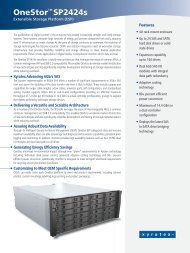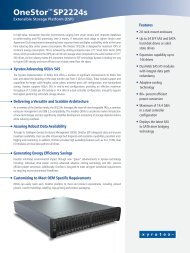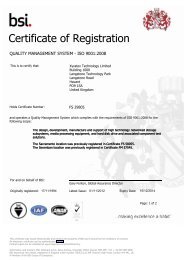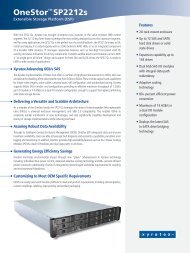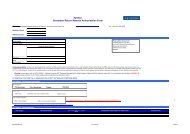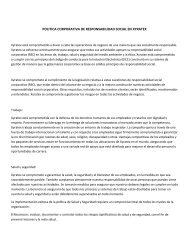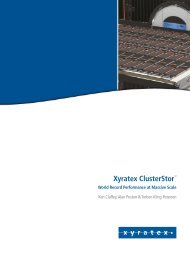Download Annual Report, 2.44 MB - Xyratex
Download Annual Report, 2.44 MB - Xyratex
Download Annual Report, 2.44 MB - Xyratex
- No tags were found...
Create successful ePaper yourself
Turn your PDF publications into a flip-book with our unique Google optimized e-Paper software.
ITEM 11: QUANTITATIVE AND QUALITATIVE DISCLOSURES ABOUT MARKET RISKThe principal market risks (i.e., the risk of loss arising from adverse changes in market rates andprices) to which we are exposed are foreign exchange rates and interest rate on cash and cashequivalents and debt.The following risk management discussion and the estimated amounts generated from analyticaltechniques are forward-looking statements of market risk assuming certain market conditions occur.Our actual results in the future may differ materially from these projected results due to actualdevelopments in the global financial markets.Foreign Exchange RatesThe functional currency for all our operations is U.S. dollars and the majority of our revenues andcost of revenues are denominated in U.S. dollars. A significant proportion of our non-U.S. dollaroperating expenses relate to our Malaysian and U.K. operations’ payroll and other expenses. The valueof the Malaysian Ringgit relative to the U.S. dollar is managed within a narrow range by the Malaysiangovernment. We are therefore particularly exposed to exchange rate movements between the U.K.pound and the U.S. dollar. We partially limit our U.K. pound exchange rate exposure through the useof forward foreign currency exchange contracts and currency options. By using these derivativeinstruments increases or decreases in our U.K. pound operating expenses resulting from changes in theexchange rate are partially offset by realized gains and losses on the derivative instruments. We do nothold derivative financial instruments for trading purposes. We also have assets and liabilitiesdenominated in U.K. pounds and therefore we are also exposed to the effect of the retranslation ofthese amounts as a result of movements in exchange rates. At November 30, 2005 we had $0.1 millionnet U.K. pound denominated liabilities. A hypothetical 10% movement in exchange rates atNovember 30, 2005 would not have significantly impacted our net earnings.We are exposed to credit (or repayment) risk through our use of forward foreign exchangecontracts. If the counter-party to one of the forward foreign exchange contracts to which we are partyfails to fulfill its performance obligations under the contract, our credit risk will equal the positivemarket value of the contract. When the fair market value of a forward foreign exchange contract ispositive, this indicates that the counter-party owes us money, thus creating a repayment risk. When thefair market value of a forward foreign exchange contract is negative, we owe the counter-party, andtherefore we assume no repayment risk. In order to minimize credit risk in forward foreign exchangecontracts, we enter into transactions with high-quality counter-parties, such as financial institutions, thatsatisfy our established credit approval criteria. Forward foreign exchange contracts are executed only onthe basis of standardized agreements.The following table provides information about our forward foreign exchange contracts existing asof November 30, 2005 and November 30, 2004:November 30,2005 2004Forward exchange contracts ......................................... $46,070 $21,127Fair value of contracts ............................................. $(1,658) $ 1,348Carrying value of contracts ......................................... $(1,658) $ 1,348Average rate of contract ........................................... $ 1.84 $ 1.76Period end rate .................................................. $ 1.72 $ 1.89Maximum period of contracts (months) ................................ 12 12Since November 30, 2005, there has not been a material change to our market exposure related toforeign exchange rates.81



